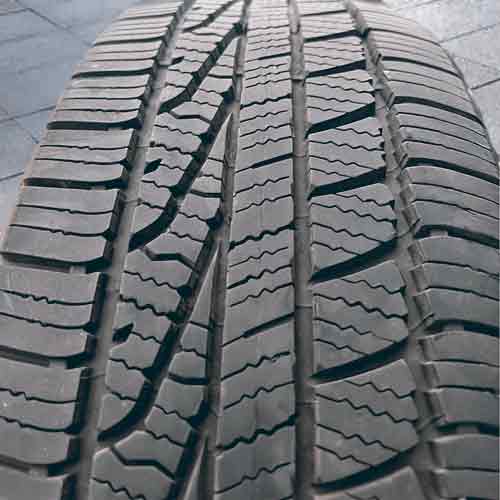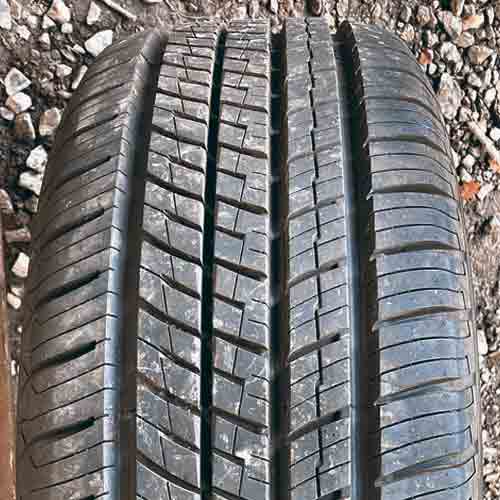When it comes to grand touring tires, the Avid Ascend GT and Goodyear WeatherReady stand out as top contenders, each offering a distinct set of features. Let’s find a better tire for you here.

Table of Contents
Key Takeaway
So overall, the Avid Ascend GT is better at:
- Enhanced dry grip and traction.
- Reduced tread noise and vibrations.
- Superior handling and cornering precision.
- Improved wet grip and water expulsion.
- Smoother ride with better impact cushioning.
The Goodyear WeatherReady is better in terms of:
- Notable mid-cornering feedback and stability.
- Superior winter performance with better snow/ice traction.
- Enhanced control over bumps and road imperfections.
- Comparable fuel efficiency with specialized tread features.
Tread Pattern
Kicking off with the Goodyear Assurance WeatherReady, this tire offers an asymmetric tread design, featuring five robust ribs or block columns.

The three central ribs form longitudinal/circumferential channels that interconnect effectively, thanks to their spacious, voided structures.
The narrowest central rib stands out with its wavy siping, in-groove notches, and offset edges, enhancing its grip and performance.
Noticeably, its lateral grooves are intricately designed with a zigzag pattern for efficient water evacuation.
Adjacent ribs exhibit distinct characteristics: one features jagged, pointy lugs with chamfered edges, while the other has zigzag edges facing the shoulders and chamfered sides.
Both ribs share the central rib’s wave-like siping.
The tire’s shoulder lugs offer consistency on either side, with one showcasing aggressive, saw-toothed grooves, and the other maintaining a sleeker design.
Internally, the tire comes with a 2-ply polyester casing, twin steel belts for strength, and a single polyamide-reinforced cap ply for durability.
Detailed Discussion of Goodyear’s tire: https://tiredriver.com/goodyear-assurance-weatherready-review/
Shifting to the Yokohama AVID Ascend GT, this tire is also recognized for its 5-rib, asymmetrical tread design.

The three central ribs, contributing to the tire’s four circumferential grooves, are designed with varying widths for optimal performance.
Out of all, the two central ribs mirror each other, featuring chamfered edges, notches, and a blend of linear lateral and longitudinal sipes.
In contrast, the third rib distinguishes itself with unique longitudinal slits and lateral siping, offering an exclusive tread feature.
Shoulder lugs on both sides are nearly identical, marked by in-groove notches and linear lateral siping, enhancing the tire’s grip and stability.
And internally, the Yokohama GT is built with a lighter construction, giving you just a single-ply polyester casing and dual wide steel belts reinforced by a single nylon cap ply.
Detailed Discussion of Yokohama’s tire: https://tiredriver.com/yokohama-avid-ascend-gt-review/
Sizes Info
The Yokohama Avid Ascend GT comes in 15 to 20 inches rims, with following specs.
- Speed ratings: H and V.
- Load ratings: SL and XL.
- Tread depth: 12/32″ on all.
- Weight range: 17 to 30 lbs.
- Treadwear warranty: 65k miles.
- UTQG rating: 740 A A.
On the other side, the Goodyear Assurance WeatherReady has sizes with following specs.
- Rim sizes: 15 to 20 inches.
- Speed ratings: T, H and V.
- Load ratings: SL and XL.
- Tread depth: Either 10/32″ or 11/32″.
- Weight range: 19 to 37 lbs.
- Winter ratings: Yes both M+S/3pmsf available.
- Tread warranty: 60k miles.
- UTQG: 700 A A.
Performance on Dry Roads
I’m going to break down the three primary aspects of dry performance: examining dry grip, handling, and steering response separately.
Directional Grip
Directional traction, or tire’s straight line grip, is quantified by measuring braking distances. And this type of grip heavily relies on the tire’s footprint and the effectiveness of its tread elements.
Now, the Yokohama Avid Ascend GT excels in this area, thanks to its streamlined central ribs, equipped with multi-directional tread elements, (those in-groove notches, I talked about in the tread section above).
Its ribs create a more consistent, robust contact with the road, while the biters enhance grip from multiple angles, significantly improving overall traction.
In contrast, the Goodyear Assurance WeatherReady, while appreciable in its performance, doesn’t quite match up to the Avid Ascend.
This is because, although the tire offers good enough biting elements too, they do more harm than good. Meaning, they take away more rubber, that could have contacted the road, and resulted with grip.
Additionally, the tire is heavier than its counterpart. And with its more open design, this means more pressure is exerted on each tread block.
So a greater weight is distributed over a smaller rubber area, leading to higher momentum inertia. And with more momentum, the tire requires more time and energy to stop.
So it makes sense why the Assurance takes almost 4 feet longer to stop, compared to Yokohama’s tire here.
Overall Handling
Cornering involves three critical phases:
- Entry Phase: Here, the vehicle prepares for the turn, often involving braking and possibly downshifting.
- Mid-Cornering: At the turn’s apex, precise steering and grip are crucial.
- Exit Phase: This stage involves realigning the vehicle and resuming acceleration.
The Yokohama Avid Ascend GT performs exceptionally well throughout these stages, offering superior steering precision.
Its excellent braking capacity allows for faster corner entry. In mid-cornering, the tire provides a reliable sense of grip.
Additionally, its heavier steering feel enhances on-center feedback, facilitating a smoother exit phase.
On the other side, the Goodyear Assurance WeatherReady lacks, particularly in post-cornering stability. This is mainly because the tire isn’t able to give you a good enough idea on when to accelerate once the turn is over.
In other words, its delaying acceleration and extending overall dry handling lap times. However, it’s worth noting that the tire does offer impressive mid-cornering feedback, leading to better slalom times in my conducted tests.
Wet Road Performance
The capability of a tire on damp roads relies on its effectiveness in removing water from the tread, bringing focus to two main performance metrics: wet traction and hydroplaning resistance. Let’s start with later.
Hydroplaning
The capacity to resist hydroplaning is a vital yet often overlooked aspect of tire performance, crucial for maintaining traction in wet conditions.
This characteristic reflects the tire’s ability to expel water through its primary grooves, quantified by float speeds (or how fast a tire can move over water before it starts to float or hydroplane).
Now this is the area, where both tires are pretty much the same, showcasing very close averaged curved and straight float speeds on my tests.
Though if we’re splitting hairs, you should know that the Yokohama has a slight edge, mainly due to its relatively greater tread depth.
Wet Grip and Handling
Both tires demonstrate competent performance in wet conditions, but to fully appreciate their capabilities, it’s essential to understand the crucial roles of sipes and grooves.
Grooves are the primary channels for water expulsion, while sipes absorb residual moisture. These sipes flex to create a vacuum effect, attracting water particles and allowing the rubber and tread elements to maintain contact with the road.
However, the Assurance WeatherReady falls short in this aspect. In fact its the weakest point of this tire, whereas the strongest of Avid Ascend.
The Yokohama GT basically offers superior full-depth siping and softer tread compound. And this combination allows for more effective water suction and road contact.
On the flip side, the Goodyear’s tire exhibits noticeable slippage, mainly due to its less flexible siping. Despite having numerous interlocking sipes, the tire’s stiffer rubber composition comes in the way.
It basically limits how much sipes can suck up the remaining water particles, compromising rubber adherence with the road.
Comfort Performance
Driving comfort is predominantly shaped by two factors: the noise produced by the tire tread and the tire’s ability to mitigate imperfections on the road. Let’s delve into each aspect separately.
Noise
The primary source of tread noise is air.
As air particles enter the tread (predominantly through the lateral voids on shoulders), they collide with the tread walls, creating pattern noise and in-groove resonance, leading to vibrations.
That’s why it makes sense why on (my comparative) tests, the Avid Ascend GT comes out quieter, with more compacted up shoulder lugs, effectively reducing the entry of air in the first place.
In contrast, the Assurance WeatherReady, with its more open tread design, tends to be noisier, where it allows air to circulate more freely, leading to greater collision and with it, noise.
Though it could have been worse, if it weren’t for its varying pitch tread design, which helps to some extent.
This design produces different tones as air strikes the tread, helping to cancel out and reduce overall noise.
So, while the WeatherReady is generally louder, as indicated by its greater decibel readings, the difference between the two isn’t excessively pronounced.
Road Vibrations
In terms of impact comfort, both tires perform appreciably, thanks to their respective designs.
The Goodyear Assurance WeatherReady offers better control over bumps due to its construction, providing a sense of stability. However, it reaches its flexibility limit quicker, resulting in more pronounced road imperfections felt within the vehicle (especially when it comes to larger bumps).
On the other hand, the Yokohama Avid Ascend GT, with its softer rubber compound and greater tread depth, excels in cushioning.
It effectively dissipates vibrations from road bumps before they reach the vehicle’s cabin, offering a smoother ride overall, though needs some controllability, (as bumps takes longer to settle down, if that makes sense).
So overall, both tires end up with equal comfort scores in my books.
Ice/Snow Grip
Winter performance is where the Goodyear shines, notably outperforming the Avid Ascend GT, in all metrics, including snow/ice braking, handling and traction.
And it makes sense because its the only tire here with 3-peak mountain snowflake (3PMSF) rating, (which the Yokohama GT lacks).
So what makes Assurance better here? Well there are 3 main factors.
- Thermally Adaptive Rubber: It remains flexible and functional at temperatures below 7 °C (44.6 °F), unlike its competitor.
- Multi-directional Grooves and Sipes: These features interlock to enhance snow-to-snow contact, crucial for effective ice and snow grip.
- Narrower Tread and Heavier Construction: These attributes press down on the snow, increasing snow-to-snow contact and thereby improving traction. And its important, because snow binds more effectively to itself than to rubber, enhancing grip in snowy conditions.
In contrast, the Yokohama Avid Ascend GT lacks these specific winter-oriented features, resulting in subpar winter traction, particularly on ice, though its snow grip is moderately adequate.
(Fuel) MPG Difference
Fuel efficiency in tires is governed by multiple factors, including:
- Tire Weight: Both the internal and external structure impact the overall weight.
- Rolling Resistance: This measures how effectively the tire adheres to the road’s surface without excessive drag.
- Rubber Composition: Certain polymers are integrated to enhance fuel economy while maintaining grip.
Now given these considerations, it can be explained why both tires end with similar MPG readings.
Now, for the Yokohama’s tire, the good thing about it is its relatively lighter weight, which directly reduces rolling friction, and with its fuel consumption.
But the thing is, the tire comes with a lot more grip, a softer tread and a greater tread depth, and all of these contribute to lowering fuel economy.
So it’s overall performance here is similar to Assurance WeatherReady.
Wrapping Up
So as you can see, both tires present distinct strengths and weaknesses across various performance metrics.
The Avid Ascend GT excels in dry grip, handling, and noise reduction due to its optimized tread elements and design, offering a smoother and quieter ride.
However, the Assurance WeatherReady shines in winter conditions with its superior snow and ice performance, attributed to its thermally adaptive rubber and specialized grooves.
Other than this, both boys provide comparable wet grip and fuel efficiency, with slight advantages in specific areas due to their unique tread patterns and rubber compositions.
So, needless to say, the choice between these tires depends on your specific needs and driving priorities.